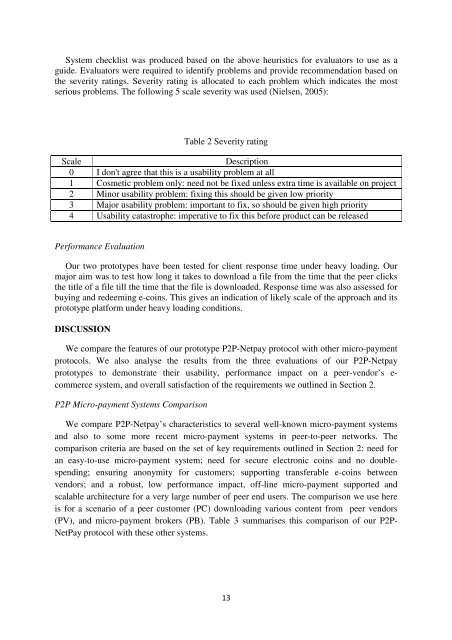View - Faculty of Information and Communication Technologies
View - Faculty of Information and Communication Technologies
View - Faculty of Information and Communication Technologies
Create successful ePaper yourself
Turn your PDF publications into a flip-book with our unique Google optimized e-Paper software.
System checklist was produced based on the above heuristics for evaluators to use as a<br />
guide. Evaluators were required to identify problems <strong>and</strong> provide recommendation based on<br />
the severity ratings. Severity rating is allocated to each problem which indicates the most<br />
serious problems. The following 5 scale severity was used (Nielsen, 2005):<br />
Table 2 Severity rating<br />
Scale<br />
Description<br />
0 I don't agree that this is a usability problem at all<br />
1 Cosmetic problem only: need not be fixed unless extra time is available on project<br />
2 Minor usability problem: fixing this should be given low priority<br />
3 Major usability problem: important to fix, so should be given high priority<br />
4 Usability catastrophe: imperative to fix this before product can be released<br />
Performance Evaluation<br />
Our two prototypes have been tested for client response time under heavy loading. Our<br />
major aim was to test how long it takes to download a file from the time that the peer clicks<br />
the title <strong>of</strong> a file till the time that the file is downloaded. Response time was also assessed for<br />
buying <strong>and</strong> redeeming e-coins. This gives an indication <strong>of</strong> likely scale <strong>of</strong> the approach <strong>and</strong> its<br />
prototype platform under heavy loading conditions.<br />
DISCUSSION<br />
We compare the features <strong>of</strong> our prototype P2P-Netpay protocol with other micro-payment<br />
protocols. We also analyse the results from the three evaluations <strong>of</strong> our P2P-Netpay<br />
prototypes to demonstrate their usability, performance impact on a peer-vendor’s e-<br />
commerce system, <strong>and</strong> overall satisfaction <strong>of</strong> the requirements we outlined in Section 2.<br />
P2P Micro-payment Systems Comparison<br />
We compare P2P-Netpay’s characteristics to several well-known micro-payment systems<br />
<strong>and</strong> also to some more recent micro-payment systems in peer-to-peer networks. The<br />
comparison criteria are based on the set <strong>of</strong> key requirements outlined in Section 2: need for<br />
an easy-to-use micro-payment system; need for secure electronic coins <strong>and</strong> no doublespending;<br />
ensuring anonymity for customers; supporting transferable e-coins between<br />
vendors; <strong>and</strong> a robust, low performance impact, <strong>of</strong>f-line micro-payment supported <strong>and</strong><br />
scalable architecture for a very large number <strong>of</strong> peer end users. The comparison we use here<br />
is for a scenario <strong>of</strong> a peer customer (PC) downloading various content from peer vendors<br />
(PV), <strong>and</strong> micro-payment brokers (PB). Table 3 summarises this comparison <strong>of</strong> our P2P-<br />
NetPay protocol with these other systems.<br />
13
















